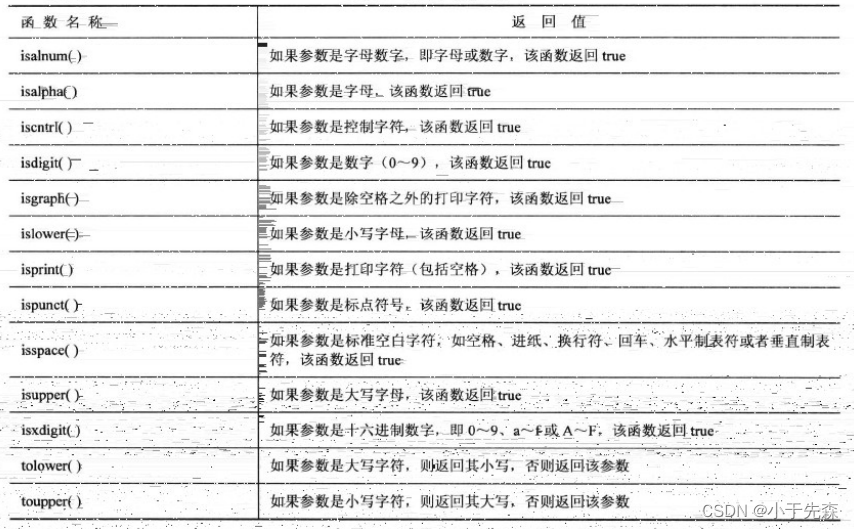1. c 与c++ string
C 中char数组 C++可使用string
2.c与c++ struct
C中 命名为 struct className varName;
C++ 可省略struct 直接 className varName;
3.指针delete的使用
- delete只能用于释放new分配的内存
- new [] 为数组分配,需使用delete[] 去释放。
- new [] 为实体分配,需使用delete去释放。
int *a = new int;
delete a ;// OK
delete a ;//not ok 不要尝试释放 释放过的指针,会引起不可预知的错误。
int b = 5;
int *c = &b;
delete c;//not ok, delete只适用于释放new 分配的内存
4.c++结构体指针跟非指针的访问
int main()
{
using namespace std;
struct things {
int good;
int bad;
};
things grubnose = {3,400};
things * pt = &grubnose;
cout << grubnose.bad << ";" << grubnose.good << endl;
cout << pt->bad << ";" << pt->good << endl;
cout << "-----------" << endl;
grubnose.good = 100;
cout << grubnose.bad << ";" << grubnose.good << endl;
cout << pt->bad << ";" << pt->good << endl;
cout << "-----------" << endl;
pt->bad = 500;
cout << grubnose.bad << ";" << grubnose.good << endl;
cout << pt->bad << ";" << pt->good << endl;
cout << (*pt).bad << ";" << (*pt).good << endl;
cout << "-----------" << endl;
return 0;
}
结果:
400;3
400;3
-----------
400;100
400;100
-----------
500;100
500;100
500;100
-----------
5.C++分配内存的方法
- 自动存储:函数内部成员变量,函数执行完毕自动释放。
- 静态存储:函数外定义,或使用static定义,运行过程中全程占用内存。
- 动态存储:new delete 运算符,new 需对应一个delete,否则易导致内存泄漏。
- 线程存储:thread_local 修饰 线程结束时被销毁
6.char 数组自己命名时需以’\0’结尾
示例: char a[] = {‘a’ , 'b' , 'c' ,'\0'}; 通过strlen 拿到的数组长度为3 ;
7.别名的两种方式
#define BYTE char; byte为char的别名。
typedeof char byte; byte为char的别名。
8.CCTYPE库中的函数以及返回值

9. c++ function中的数组参数其实是指针,所以无法通过sizeof拿到具体长度。
示例:
int calcArray(int b [],int count){
cout << "b size = " << sizeof b << endl;
int sum = 0;
for (int i = 0; i < count; i++)
{
sum += b[i];
}
return sum;
}
int main()
{
const int NUM = 4;
int a[NUM] = {1,2,3,4};
cout <<"a size = " << sizeof a << endl;
int sum = calcArray(a,NUM);
cout << "sum = " << sum << endl;
return 0 ;
}
结果为:
a size = 16
b size = 8
sum = 10
11.const的一些运用
- 指针
int a = 10;
const int *pt = &a ;//指针pt不可以修改a的值,但是可以更换指向地址,即不可以 *pt = 20 ,但可以 pt = &b;
int * const pt = &a ;//指针pt可以修改a的值,但是不可以更换指向地址,即可以 *pt = 20 ,但不可以 pt = &b;
const int * const pt = &a ;//指针pt即不可以修改a的值,也不可以更换指向地址
- 方法
int queueCount() const;//此方法实现内不允许修改成员变量。
bool enQueue(const Item & item);//只有读item的权限
const Item get();//只有Item返回的读权限
12.C++中除数组默认为指针传递外,其他结构默认均为值copy传递(即在方法内修改不会影响原始数据的值)
引用传递,方法内修改也会影响原始数据值。
引用传递时需注意参数跟传递内容需类型一致,否则可能无法达到预期效果 \color{#FF0000}{引用传递时需注意参数跟传递内容需类型一致,否则可能无法达到预期效果} 引用传递时需注意参数跟传递内容需类型一致,否则可能无法达到预期效果
13.C++中为方法参数设置默认值只能从右往左设置
void test(int a,int b,int c = 10);//valid
void test(int a = 9,int b = 10,int c = 10);//valid
void test(int a,int b = 10,int c);//Invalid
void test(int a = 10,int b ,int c);//Invalid
14.C++11 explicit 强制显示修饰符可用于转换函数。
15.C++ 涉及统计现存实例个数,需重写构造函数,复制构造函数,赋值构造函数,
private:
static int num_strings;//统计实例个数
StringBad::StringBad(const char * s ){//构造
num_strings++;
}
StringBad::StringBad() : StringBad("def"){//构造
}
StringBad::StringBad(const StringBad & s){//复制构造
num_strings++;
}
StringBad & StringBad::operator=(const StringBad &s){//赋值
num_strings++;
}
如不想重写赋值,复制构造函数,可将其放入私有模块。
16. virtual 修饰符的使用
类集成场景:如不加virtual,指针调用方式时将默认调用指针类型的犯法:
.h:
class Animal
{
private:
protected:
string name;
public:
Animal(const string & n) : name(n){
cout << "Animal Construct method" << endl;
};
~Animal(){};
virtual void cry(){
cout << "Animal cry" << endl;
}
void eat(){
cout << name << " is eating fast" << endl;
}
};
class Elephant : public Animal
{
private:
int noseLength;
public:
Elephant(int noseLength ) : Animal("Elephant"){
Elephant::noseLength = noseLength;
cout << "Elephant is call; length" << Elephant::noseLength << endl;
}
~Elephant(){
};
virtual void cry(){
cout << "Elephant cry" << endl;
}
void eat(){
cout << name << " is eating slowly" << endl;
}
void run(){
cout << "I am an elephant , I'm running" << endl;
}
};
.cpp:
int main()
{
Animal bird = Animal("Bird");
Elephant el = Elephant(18);
Animal * a1, * a2;
a1 = &bird;
a2 = ⪙
a1->eat();
a2->eat();
a1->cry();
a2->cry();
}
out:
"d:\UnRealWorkSapce\CplusStudy\chapter13\extend\"testmain
Animal Construct method
Animal Construct method
Elephant is call; length18
Bird is eating fast
Elephant is eating fast
Animal cry
Elephant cry
可以发现 使用了virtual修饰符的指针会调用具体指向的类作用域中的方法。而未使用的会直接使用指针类作用域中的方法。
什么时候推荐使用virtual修饰符:
- 析构函数(防止内存泄漏)
- 派生类中重写了基类函数的函数(有点绕)。
17.c++中的容器类型
deque,list,queue,priority_queue,stack,
vector,map,multimap,set,multiset,bitset,forward_list,
unordered_map,unordered_multimap,unordered_multiset.
18.copy构造跟赋值构造函数区分
未被定义的使用copy构造,已被定义使用赋值,示例
class B
{
private:
/* data */
public:
B(/* args */);
~B();
B(B& b);//Copy构造
B& operator=(B& b);//copy赋值
};
int main()
{
B a;
B b;
B c = a;//Copy构造
b = a ;//Copy赋值
return 0;
}






















 7万+
7万+











 被折叠的 条评论
为什么被折叠?
被折叠的 条评论
为什么被折叠?










